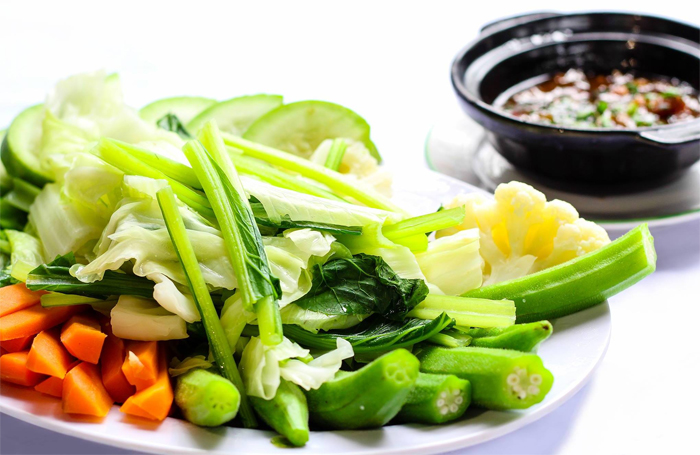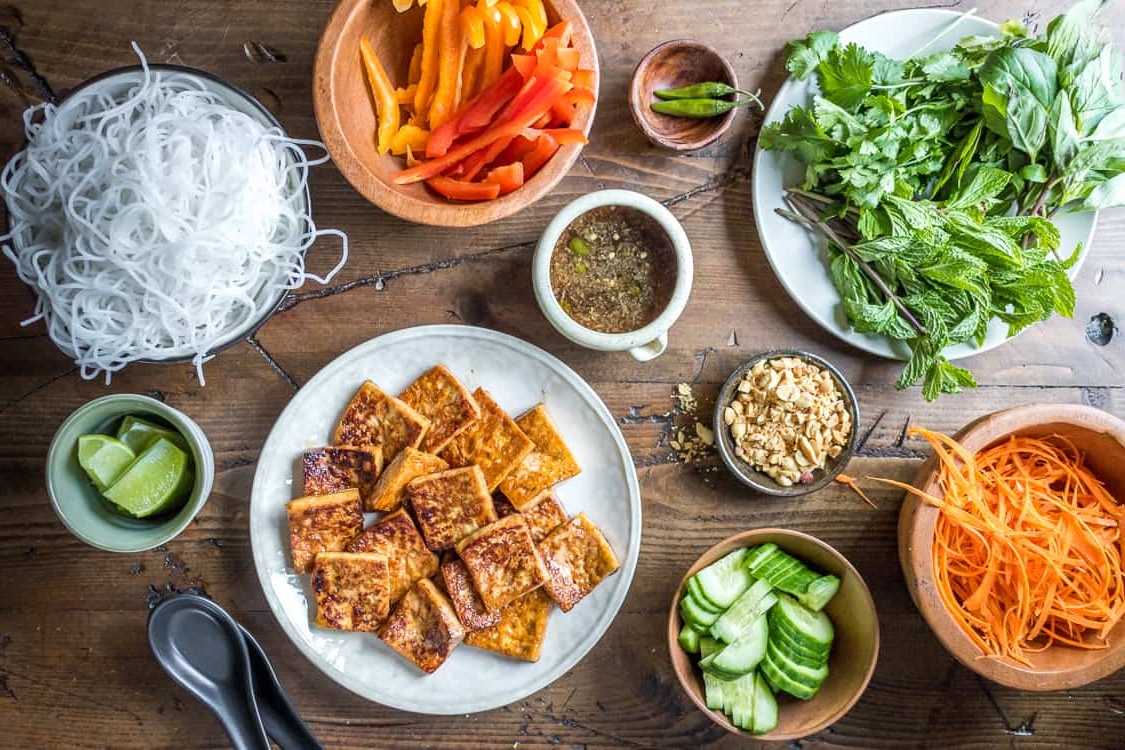Vegetarian Vietnamese food is a vibrant and flavorful cuisine that celebrates the abundance of fresh produce, herbs, and spices found in Vietnam. Rooted in the country’s rich culinary heritage, vegetarian dishes showcase the balance and harmony of flavors that characterize Vietnamese cooking.
From savory soups and salads to hearty main courses and delectable desserts, vegetarian Vietnamese cuisine offers a wide range of options that cater to diverse tastes and preferences.
Vietnamese Cuisine and Vegetarianism
Vietnamese cuisine is renowned for its vibrant flavors, fresh ingredients, and diverse culinary traditions. It emphasizes the use of herbs, spices, and vegetables, creating a harmonious balance of sweet, sour, salty, and spicy flavors. The cuisine has been influenced by various cultures throughout history, including Chinese, French, and Indian, resulting in a unique and delectable blend of flavors.
Vegetarianism has a significant presence in Vietnamese culture, with a large proportion of the population practicing vegetarianism for religious or health reasons. This has led to the development of a rich and diverse vegetarian cuisine that showcases the versatility and creativity of Vietnamese cooking.
Vegetarian dishes in Vietnam often feature an array of vegetables, tofu, and other plant-based ingredients, providing a nutritious and flavorful alternative to meat-based dishes.
Prevalence of Vegetarianism in Vietnamese Cuisine
The prevalence of vegetarianism in Vietnamese cuisine is evident in the abundance of vegetarian restaurants and street food stalls throughout the country. Vegetarian dishes are commonly found on menus in both traditional and modern Vietnamese restaurants, catering to the growing demand for plant-based options.
Additionally, many Vietnamese families have a tradition of observing vegetarian days during the month, contributing to the widespread availability and popularity of vegetarian food.
Common Ingredients and Dishes

Vietnamese cuisine features a diverse range of vegetarian-friendly ingredients and dishes. These ingredients offer a rich array of flavors and textures, creating a vibrant and satisfying culinary experience.
The following table lists some of the most common vegetarian ingredients used in Vietnamese cooking, along with a brief description and examples of dishes where they are used:
Ingredients
| Ingredient | Description | Examples |
|---|---|---|
| Tofu | A versatile soy-based ingredient that can be steamed, fried, or grilled. It absorbs flavors well and is a good source of protein. | Tofu stir-fry, tofu banh xeo (Vietnamese crispy pancake) |
| Tempeh | Another soy-based ingredient made from fermented soybeans. It has a nutty flavor and chewy texture. | Tempeh stir-fry, tempeh banh mi (Vietnamese sandwich) |
| Mushrooms | A variety of mushrooms, such as shiitake, oyster, and wood ear, are commonly used in Vietnamese vegetarian dishes. They provide umami and a meaty texture. | Mushroom pho (Vietnamese noodle soup), mushroom spring rolls |
| Bamboo shoots | Crunchy and slightly sweet, bamboo shoots are a staple ingredient in many Vietnamese dishes. They add texture and a fresh flavor. | Bamboo shoot salad, bamboo shoot stir-fry |
| Bean sprouts | Fresh and crunchy, bean sprouts are often used as a garnish or in stir-fries. They add a crisp texture and a mild flavor. | Bean sprout stir-fry, bean sprout banh mi |
Popular Vegetarian Dishes
Vietnamese cuisine boasts a wide range of vegetarian dishes that cater to diverse tastes and preferences. These dishes showcase the vibrant flavors and culinary techniques that define Vietnamese cooking, using fresh vegetables, aromatic herbs, and savory sauces.
The following table highlights some of the most popular vegetarian dishes found in Vietnamese cuisine, along with their key ingredients and brief descriptions:
Popular Vegetarian Dishes
| Dish | Ingredients | Description |
|---|---|---|
| Bún chả chay | Rice noodles, grilled tofu, pickled vegetables, dipping sauce | A savory dish featuring grilled tofu served with rice noodles, pickled vegetables, and a flavorful dipping sauce. |
| Phở chay | Rice noodles, vegetable broth, tofu, vegetables | A comforting soup dish made with rice noodles in a savory vegetable broth, topped with tofu and an assortment of vegetables. |
| Gỏi cuốn chay | Rice paper wrappers, vermicelli noodles, vegetables, herbs | Fresh spring rolls filled with vermicelli noodles, vegetables, herbs, and sometimes tofu, served with a dipping sauce. |
Regional Variations
Vegetarian Vietnamese cuisine showcases regional diversity, with each area boasting unique dishes and cooking styles that reflect local ingredients and traditions.
Northern Vietnam is known for its lighter flavors and emphasis on fresh vegetables. Common dishes include bún chả giò(vermicelli noodles with spring rolls) and phở chay(vegetarian pho). The central region is renowned for its spicy dishes, such as cơm hến chay(vegetarian clam rice) and bún bò Huế chay(vegetarian Hue beef noodle soup).
Southern Vietnam
Southern Vietnam is known for its rich flavors and use of coconut milk. Vegetarian dishes from this region include cà ri chay(vegetarian curry), bánh xèo chay(vegetarian rice pancakes), and bún mắm chay(vegetarian fermented fish noodle soup).
Health Benefits and Nutrition: Vegetarian Vietnamese Food

Vegetarian Vietnamese food offers an array of health benefits due to its emphasis on fresh, unprocessed ingredients and nutrient-rich vegetables. These dishes are naturally low in saturated fat and cholesterol, while being abundant in fiber, vitamins, minerals, and antioxidants.
The high fiber content in vegetarian Vietnamese dishes promotes satiety and supports a healthy digestive system. Fiber helps regulate blood sugar levels, reducing the risk of chronic diseases such as type 2 diabetes and heart disease. Additionally, the presence of vitamins and minerals, including vitamin C, vitamin A, iron, and calcium, contributes to overall well-being and supports immune function.
Antioxidants
Vegetarian Vietnamese food is a rich source of antioxidants, which play a crucial role in protecting the body against oxidative stress and chronic diseases. Antioxidants neutralize free radicals, unstable molecules that can damage cells and contribute to aging and the development of certain diseases.
The consumption of antioxidant-rich foods, such as those found in vegetarian Vietnamese cuisine, has been linked to a reduced risk of chronic conditions, including cancer, heart disease, and neurodegenerative disorders.
Vegetarian Substitutions
Vegetarianism has become increasingly popular in Vietnam, leading to the development of many creative vegetarian substitutes for traditional non-vegetarian ingredients. These substitutions allow vegetarians and vegans to enjoy the rich flavors of Vietnamese cuisine without compromising their dietary preferences.
One of the most common non-vegetarian ingredients in Vietnamese cooking is meat. Vegetarian substitutes for meat include:
Meat Substitutes, Vegetarian vietnamese food
- Tofu:A versatile plant-based protein made from soybeans, tofu can be used in a variety of dishes, including stir-fries, soups, and curries.
- Tempeh:Another soybean-based protein, tempeh has a firmer texture than tofu and can be used in dishes such as stir-fries, sandwiches, and wraps.
- Seitan:Made from wheat gluten, seitan has a chewy texture and can be used in dishes such as stir-fries, curries, and stews.
- Jackfruit:A tropical fruit with a meaty texture, jackfruit can be used in dishes such as curries, tacos, and pulled “pork” sandwiches.
- Mushrooms:Mushrooms, such as shiitake, oyster, and portobello, can be used to add umami and texture to dishes.
Another essential ingredient in Vietnamese cooking is fish sauce. Vegetarian substitutes for fish sauce include:
Fish Sauce Substitutes
- Soy sauce:A fermented sauce made from soybeans, soy sauce can be used to add saltiness and umami to dishes.
- Tamari:A gluten-free soy sauce, tamari is a good option for those with gluten sensitivities.
- Coconut aminos:A fermented sauce made from coconut sap, coconut aminos has a slightly sweet flavor and can be used as a substitute for fish sauce in many dishes.
- Vegetable broth:Vegetable broth can be used to add flavor and moisture to dishes.
Presentation and Etiquette
Vegetarian Vietnamese meals are typically presented in a communal style, with dishes shared among diners. Each dish is served in its own bowl or plate, and diners use their chopsticks to select items from the shared dishes. It is considered polite to take only small portions of each dish, and to leave some food behind for others.Table
manners are generally relaxed, but there are a few basic rules to follow. Diners should avoid talking while chewing, and they should not slurp their food. It is also considered rude to point chopsticks at someone or to stick them into food.
Serving Dishes
Vegetarian Vietnamese meals are often served in a variety of serving dishes. These dishes can include:
- Bowls: Bowls are used to serve soups, stews, and other liquid dishes.
- Plates: Plates are used to serve rice, noodles, and other solid dishes.
- Trays: Trays are used to serve appetizers, snacks, and other small dishes.
General Inquiries
What are some common ingredients used in vegetarian Vietnamese cooking?
Common ingredients include tofu, tempeh, mushrooms, vegetables, herbs, and spices such as lemongrass, ginger, and turmeric.
What are some popular vegetarian Vietnamese dishes?
Popular dishes include pho (noodle soup), banh xeo (savory pancakes), goi cuon (fresh spring rolls), and com tam (broken rice with grilled vegetables).
Is vegetarian Vietnamese food healthy?
Yes, vegetarian Vietnamese food is generally considered healthy due to its emphasis on fresh produce, lean proteins, and minimal use of oil.
